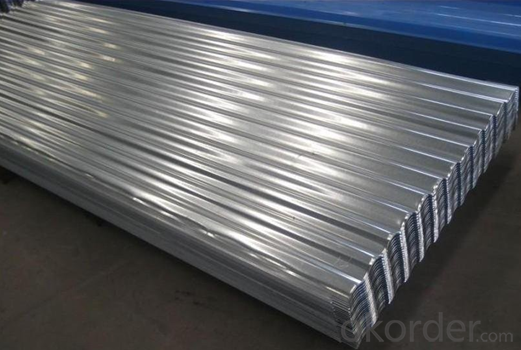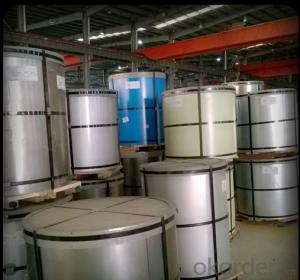Pre-Painted Steel Coil Thickness 0.9mm Width 900mm-1250mm
- Loading Port:
- China main port
- Payment Terms:
- TT OR LC
- Min Order Qty:
- 50 m.t.
- Supply Capability:
- 1000000 m.t./month
OKorder Service Pledge
OKorder Financial Service
You Might Also Like
Product Description
Prime CGCC RAL DX51D Z60 Z100 Color Coated Steel/ PPGI/Color Prepainted Galvanized Steel Coil(China)
FOB Price: US $630 - 938 / Ton Get Latest Price
Min. Order Quantity: 15 Ton/Tons
Supply Ability: 5000000 Ton/Tons per year
Port: Qingdao, Tianjin, China
Payment Terms: L/C, T/T, Western Union
Contact Supplier
Company Information
Quick Details
Standard: AISI, ASTM, BS, DIN, GB, JISGrade: SGCC SGCD SGCH DX51D/52D/53DThickness: 0.22-1.0 mm
Place of Origin: Tianjin China (Mainland)Model Number: CGCC CGCL PPGI PPGLType: Steel Coil
Technique: Cold RolledSurface Treatment: CoatedApplication: Container Plate
Special Use: Wear Resistant SteelWidth: 750-1250mmLength: Coil Or Sheet (780-6000 mm ) can be done as your requirements.
Exporting Ability: 500 20ft container/each monthZinc Coating: Z40--Z180g/m2Painting: Front side paint thickness: 15-25μ M (bottom paint + top paint)
Sample: Offer Free Sample For Quality TestContainer Info: One 20ft container can hold 26tons MaxColor: As the RAL color chart
Coil I. D: 508/610 mmCoil Weight: 3.5-8 tons/each coilOther Poducts: Cold rolled, galvanized steel coils
NAME | PPGI | GALVANIZED | GALVALUME/ALUZINC |
CERTIFICATE | ISO9001:2008 | ||
| EN10142 | ASTM A653 | ASTM A792 |
| CGCC | SS GRADE33-80 | GRADE33-80 |
MODEL NO | 0.16MM-1.5MM*1250MM OR UNDER | (0.12-1.5)*1250MM OR UNDER | 0.16MM-1.5MM*1250MM OR UNDER |
| Steel coil | Steel coil | Steel coil |
| Hot rolled-cold rolled | Hot rolled-cold rolled | Hot rolled-cold rolled |
SURFACE | Mini/regular/big/zero spangle, | Mini/regular/big/zero spangle, | |
APPLICATION | Structural use ,roofing, commercial use, household appliance, industry, family | ||
SPECIAL | Wear resistant steel, high- strength - steel plate | ||

FAQ
1.What's your MOQ?
25MT, it is for one container.
- Q:Can steel coils be used in the production of consumer goods?
- Consumer goods can indeed be produced using steel coils. In multiple industries, including automotive, construction, and manufacturing, steel coils are commonly employed as raw materials. Within the consumer goods sector specifically, steel coils can be utilized to manufacture a diverse array of items, spanning from appliances, furniture, and tools to packaging materials and even consumer electronics. The innate strength, durability, and adaptability of steel render it an optimal choice for fabricating consumer goods that necessitate stability, safety, and longevity. Furthermore, steel coils can be easily manipulated, molded, and shaped into distinct components or parts, enabling customization and design flexibility throughout the production process. Consequently, steel coils play an indispensable role in consumer goods production and find widespread use across various industries.
- Q:What are the common methods of preserving steel coils?
- Some common methods of preserving steel coils include applying protective coatings, such as oil or paint, to prevent corrosion and rust formation. Another method is using VCI (Vapor Corrosion Inhibitor) paper or film, which releases chemicals that prevent oxidation. Additionally, steel coils can be stored in climate-controlled environments or wrapped in moisture-resistant materials to minimize exposure to moisture and humidity, which can accelerate corrosion.
- Q:So...I'm learning about how steel is made and I'm wondering if there is a more environmentally friendy method. I view it as unfriendly b/c of the oxygen that is injected when the steel is in the blast furnace or electric arc furnace. This oxygen bonds w/ the carbon to produce CO and CO2. THis is necessary to reduce the amount of carbon content to produce harder steels. So what other methods are there that can be used w/o having to end up w/ co and co2? thanks
- From what I understand of it, US steel is better as the steel is more recycled than Canadian, so a lot of that oxygen / CO2 has already taken place compared to working from ore. The second reason US steel is environmentally ahead of Canadian is that US tends to use Electric Arc, while Canadian uses Basic Oxygen, Basic Oxygen uses more energy than electric arc, and I think it also uses more oxygen, but I would suspect that oxygen that it uses is 'waste oxygen' and not converted into Co2 because the Co2 process is limited by the carbon, and steel only has so much carbon.
- Q:Can steel coils be coated with heat-resistant materials?
- Yes, steel coils can be coated with heat-resistant materials. Coating steel coils with heat-resistant materials provides protection against high temperatures and ensures the durability and longevity of the coils in various industrial applications.
- Q:Hello,is it possible to divide an alloy in its own elements? I am particularly interested in Stainless Steel, which is made of Nickel, Chrome and Iron. Do you have an idea of where can I find some more information (blogs, reviews, sites or books)?Thanks for your help
- Yes it is possible to recover individual elements from an alloy such as stainless steel, but not easy. Look up etching of stainless steel on google. This same etching solution will completely dissolve stainless steel. These solutions are strong acids such as H2SO4 and HNO3 so safety goggles and good ventilation are absolutely required. Once the metal has been dissolved, then you would need to use a qualitative analysis scheme to precipitate out the different metals one at a time as compounds, then do additional reactions to recover the metallic elements.
- Q:I'm looking to get a track bike/ fixie to ride around the city of Chicago. I've looked at many bikes and they're mostly made out of Hi Ten steel. My old fixie (which was stolen at North Ave Beach) was made out of aluminum (KHS FLITE 100). How big of a difference is it between aluminum and steel? I know steel is heavier but how does it effect the ride? Is a aluminum bike or a steel bike better to get to ride around the bike path and in the city of Chicago?
- Have you considered going to a motorcycle keep and watching at hybrid or commuter bikes? These will fall into cost range (ie. KHS, Fuji,and so on.). Aluminum is probably lighter than steel however the add-ons could make difference in the weight too. Go together with a motorbike shop that means you will be purchasing from folks who understand what they are selling. A series like performance Bike is a good way to go. The costs are right and which you can get a a lot bigger great bike in your money than you'll in finding at a department retailer, plus they provide lifetime free changes and tuneups.
- Q:How do steel coils contribute to corrosion resistance in products?
- Steel coils contribute to corrosion resistance in products through a combination of factors. Firstly, steel coils are often made from stainless steel, which contains a high amount of chromium. Chromium forms a protective oxide layer on the surface of the steel, known as a passive film, which acts as a barrier against corrosion. This passive film is self-healing, meaning that if it gets damaged or scratched, it can regenerate itself, ensuring continued protection against corrosion. Additionally, steel coils undergo a process called galvanization, where a layer of zinc is applied to the surface of the steel. This zinc layer acts as a sacrificial anode, meaning that it will corrode preferentially to the steel. This sacrificial corrosion protects the steel underneath, effectively preventing rust and other forms of corrosion from developing. Moreover, steel coils can be coated with various protective coatings, such as epoxy or polyurethane, to further enhance their corrosion resistance. These coatings provide an additional physical barrier that prevents moisture, chemicals, and other corrosive elements from reaching the steel surface. Lastly, steel coils can be manufactured with specific alloying elements, such as nickel or molybdenum, which further improve their resistance to corrosion. These alloying elements enhance the strength and durability of the steel, making it better able to withstand corrosive environments. Overall, steel coils contribute to corrosion resistance in products by utilizing stainless steel, galvanization, protective coatings, and alloying elements. By implementing these measures, steel coils ensure that products maintain their structural integrity and appearance over time, even in harsh and corrosive conditions.
- Q:like the steel industry and the effects it had on industrial growth, 10 points!
- The single most important important advance in steel production was learning to accurately control carbon content. This was done through the Bessemer Process in which air was blown through molten iron to burn out impurities and excess carbon. Low carbon iron (wrought iron) could be easily worked into shapes. Medium carbon iron could be cast into useful and durable shapes. High carbon steel could be used for structural uses (beams and girders). Adding alloys such as nickel and silicon could produce very tough steels and steels resistant to rust. Adding vanadium to steel engine parts allowed Ford to produce finely machined engines in huge numbers with existing machinery.
- Q:How is the thickness of a steel coil measured?
- The thickness of a steel coil is typically measured using a device called a thickness gauge or micrometer. This tool consists of a calibrated mechanical or digital system that measures the distance between two opposing surfaces of the steel coil. By placing the gauge on the coil and applying pressure, the thickness can be accurately determined.
- Q:How are steel coils heat treated?
- Annealing is the method used to heat treat steel coils, resulting in improved mechanical properties and overall performance. To achieve this, the coils are heated to a specific temperature and slowly cooled down. This process relieves internal stresses within the steel and enhances its performance. To begin the heating process, the steel coils are raised to a critical temperature, typically between 800°C and 900°C, depending on the desired outcome. They are then maintained at this temperature for a specific period of time, allowing for the transformation of the steel's microstructure. Once the desired time has passed, the heated coils are carefully cooled down in a controlled manner. This gradual cooling process is crucial as it allows for a uniform and refined microstructure. It also helps prevent the formation of internal stresses that could weaken the steel. The annealing process can be conducted in various atmospheres, such as air, nitrogen, or hydrogen. The choice of atmosphere depends on the specific requirements and properties desired for the steel coils. For example, annealing in a protective atmosphere like nitrogen or hydrogen can prevent oxidation or decarburization of the steel surface. In conclusion, annealing is a crucial step in heat treating steel coils, resulting in improved mechanical properties, enhanced formability, and the desired characteristics for industrial applications.
1. Manufacturer Overview |
|
|---|---|
| Location | |
| Year Established | |
| Annual Output Value | |
| Main Markets | |
| Company Certifications | |
2. Manufacturer Certificates |
|
|---|---|
| a) Certification Name | |
| Range | |
| Reference | |
| Validity Period | |
3. Manufacturer Capability |
|
|---|---|
| a)Trade Capacity | |
| Nearest Port | |
| Export Percentage | |
| No.of Employees in Trade Department | |
| Language Spoken: | |
| b)Factory Information | |
| Factory Size: | |
| No. of Production Lines | |
| Contract Manufacturing | |
| Product Price Range | |
Send your message to us
Pre-Painted Steel Coil Thickness 0.9mm Width 900mm-1250mm
- Loading Port:
- China main port
- Payment Terms:
- TT OR LC
- Min Order Qty:
- 50 m.t.
- Supply Capability:
- 1000000 m.t./month
OKorder Service Pledge
OKorder Financial Service
Similar products
New products
Hot products
Related keywords





























